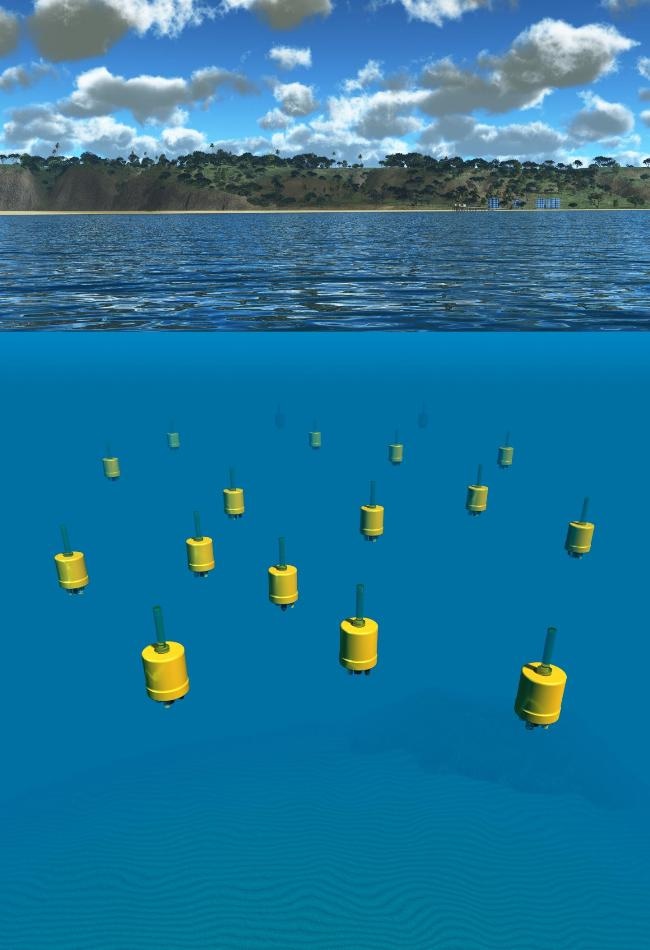Jan 25 2017
 This is a graphic representation of the M-AUEs underwater. CREDIT: Scripps Oceanography/Jaffe Lab for Underwater Imaging.
This is a graphic representation of the M-AUEs underwater. CREDIT: Scripps Oceanography/Jaffe Lab for Underwater Imaging.
Researchers from Scripps Institution of Oceanography at the University of California San Diego have recently developed innovative underwater robots. These robots enable scientists to not only analyze ocean currents but also the tiny creatures transported by the currents. These underwater robots helped to explain certain basic queries related to plankton, the most abundant life form in the ocean.
Jules Jaffe, Scripps research oceanographer, designed and constructed the miniature autonomous underwater explorers (M-AUEs) in order to analyze small-scale environmental processes occurring in the ocean. When the robots “swim” up and down and remain at a constant depth by regulating their buoyancy, the temperature and other sensors integrated in the ocean-probing instruments measure the surrounding ocean conditions.
Swarms of hundreds to thousands of M-AUEs can be potentially stationed to obtain a three-dimensional view of the interactions between marine life and ocean currents.
Jaffe and Scripps biological oceanographer Peter Franks stationed a swarm of 16 grapefruit-sized robots that were programmed to imitate the underwater swimming behavior of plankton, which drifts along with the oceanic currents. The study has been published in the 24 January issue of Nature Communications. This study was proposed to analyze the theories explaining how plankton form dense patches under the ocean surface, which are then revealed at the surface as red tides.
“These patches might work like planktonic singles bars,” stated Franks, who has long doubted that the dense patches might help to feed, reproduce, and protect from predators.
20 years ago, a mathematical theory was published by Franks, which speculated that swimming plankton form dense patches when they are pushed around by internal waves, i.e. giant, slow-moving waves under the ocean surface. In order to test his theory, the movements of individual plankton (smaller than a grain of rice) ought to be tracked when they swim in the ocean. This is highly impossible using the prevalent technology.
As an alternative, Jaffe developed “robotic plankton” with the ability to drift along with the ocean currents, and programmed to move up and down by regulating their buoyancy, mimicking the movements of plankton. The ideal tool for ultimately testing Franks’ mathematical theory was a swarm of the robotic plankton.
The big engineering breakthroughs were to make the M-AUEs small, inexpensive, and able to be tracked continuously underwater.
Jules Jaffe, University of California San Diego
The low cost of the robots enabled Jaffe and his colleagues to construct a small number of robots to be stationed as a swarm.
However, it was challenging to track the individual M-AUEs because GPS does not work underwater. The mathematical techniques for using acoustic signals to track the submerged M-AUE vehicles, developed by researchers at UC San Diego’s Qualcomm Institute and Department of Computer Science and Engineering, proved to be a crucial component of the project.
The Scripps researchers and their UC San Diego collaborators worked on a 5-hour experiment to deploy a swarm of 16 M-AUEs (a 300-m, or 984-ft, diameter swarm) which were programmed to be positioned at a depth of 10 m, or 33 feet, in the ocean off the coast of Torrey Pines, near La Jolla, California.
The M-AUEs were able to constantly regulate their buoyancy to move vertically against the currents formed by the internal waves. The location to which the robotic swarm moved under the ocean surface was revealed by the three-dimensional location information acquired every 12 seconds.
The outcomes of the analysis were almost indentical to the predictions of Franks. When the internal waves passed through the swarm of M-AUEs, there was a fluctuation in the surrounding ocean temperatures, and holding good Franks’ predictions, the M-AUE location data indicated that a tightly packed patch was formed by the M-AUE swarm in the warm waters of the internal wave troughs. However, the patch dispersed over the wave crests.
“This is the first time such a mechanism has been tested underwater,” stated Franks.
With the help of the experiment, the researchers could confirm the usage of the physical dynamics of the ocean (here, internal waves) by free-floating plankton, thereby increasing their concentrations and clustering into swarms to satisfy the basic requirements of their life cycle.
“This swarm-sensing approach opens up a whole new realm of ocean exploration,” stated Jaffe. As explained by Jaffe, the photographic mapping of coral habitats (i.e. “plankton selfies) can be carried out by using M-AUE supplemented with cameras.
The researchers are aiming to construct more of these miniature robots to monitor harmful red tide blooms, analyze the movement of larvae between marine protected areas, and help in tracking oil spills. The onboard hydrophones which track the underwater M-AUEs can also enable the swarm to function as a giant “ear” that listens to and localizes ambient sounds in the ocean.
In 2009, a research fund of almost $1 million was awarded to Jaffe, Franks, and their collaborators by the National Science Foundation to develop and test the new-generation ocean-probing instruments. Paul Roberts, principal development engineer at Scripps; Ryan Kastner, professor in the Department of Computer Science and Engineering; Diba Mirza, postdoctoral researcher in computer science; Curt Schurgers, principal development engineer at the Qualcomm Institute; and Adrien Boch, Scripps student intern are the coauthors of the study.